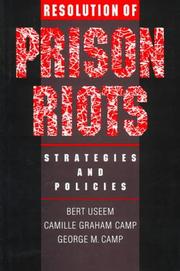| Listing 1 - 10 of 52 | << page >> |
Sort by
|
Dissertation
ISBN: 9051666330 Year: 1998 Publisher: Delft Eburon
Abstract | Keywords | Export | Availability | Bookmark
 Loading...
Loading...Choose an application
- Reference Manager
- EndNote
- RefWorks (Direct export to RefWorks)
Leadership --- Prison administration --- -Prison administration --- -Administration of prisons --- Prison management --- Prisons --- Management --- Ability --- Command of troops --- Followership --- Administration --- Theses --- Leadership. --- -Theses --- Administration of prisons

ISBN: 1280441925 0195357647 1602560137 9781602560130 9780195357646 9780195093247 0195093240 9786610441921 6610441928 0195093240 019774334X Year: 2023 Publisher: New York : Oxford University Press,
Abstract | Keywords | Export | Availability | Bookmark
 Loading...
Loading...Choose an application
- Reference Manager
- EndNote
- RefWorks (Direct export to RefWorks)
The book uses eight diverse case studies of prison riots to explore how the outcomes were affected by policies, procedures, management, communications, and strategy immediately before, during, and after the riot. Exploring the results achieved by negotiation, by force, and by simply waiting, the authors illuminate the factors most important in controlling the costs of damage and human suffering that can result from increasingly common prison disturbances.
Prison riots --- Prison administration --- Prison violence --- Riots --- Administration of prisons --- Prison management --- Prisons --- Management --- Prevention. --- Administration
Book
ISBN: 981169656X 9811696578 Year: 2022 Publisher: Singapore : Springer,
Abstract | Keywords | Export | Availability | Bookmark
 Loading...
Loading...Choose an application
- Reference Manager
- EndNote
- RefWorks (Direct export to RefWorks)
Prison administration. --- Prison administration --- Administration of prisons --- Prison management --- Prisons --- Management --- Administration
Book
ISBN: 1626373205 9781626373204 Year: 2022 Publisher: Boulder
Abstract | Keywords | Export | Availability | Bookmark
 Loading...
Loading...Choose an application
- Reference Manager
- EndNote
- RefWorks (Direct export to RefWorks)
Through case studies of two prison systems—the U.S. Federal Bureau of Prisons and the Dutch prison system—Arjen Boin identifies the challenges and opportunities that confront public managers who want to reorient correctional policy and make prisons more effective. Crafting Public Institutions contrasts the two prison systems to show how focused leadership—or its absence—can make a major difference in the character and performance of public organizations. The ability of leaders to shape an organization's mission and motivate public servants in accordance with policy goals, Boin concludes, lies at the heart of making institutions work.
Prison administration --- Institution building --- Social change --- Social institutions --- Social policy --- Administration of prisons --- Prison management --- Prisons --- Management --- Administration
Book
ISBN: 0901382183 Year: 1997 Publisher: Cambridge University of Cambridge. Institute of criminology
Abstract | Keywords | Export | Availability | Bookmark
 Loading...
Loading...Choose an application
- Reference Manager
- EndNote
- RefWorks (Direct export to RefWorks)
Prison administration --- Prison discipline --- Prisons --- Congresses. --- Dungeons --- Gaols --- Penitentiaries --- Correctional institutions --- Imprisonment --- Prison-industrial complex --- Discipline, Prison --- Penal discipline --- Discipline --- Administration of prisons --- Prison management --- Management --- Congresses --- Administration

ISBN: 9780415627856 9781843922230 1843922231 9781843926573 9781134020799 9781134020867 9781134020935 Year: 2007 Publisher: Cullompton : Willan,
Abstract | Keywords | Export | Availability | Bookmark
 Loading...
Loading...Choose an application
- Reference Manager
- EndNote
- RefWorks (Direct export to RefWorks)
Prison administration. --- Prisons --- Officials and employees. --- Prison administration --- Correctional personnel --- Administration of prisons --- Prison management --- Management --- Officials and employees --- Employees --- Administration
Book
ISBN: 9515305675 Year: 1996 Publisher: Helsinki HEUNI
Abstract | Keywords | Export | Availability | Bookmark
 Loading...
Loading...Choose an application
- Reference Manager
- EndNote
- RefWorks (Direct export to RefWorks)
Prison administration --- Administration of prisons --- Prison management --- Prisons --- Administration --- Management --- Europe --- PRISONS --- DROITS DE L'HOMME --- EUROPE CENTRALE ET ORIENTALE --- EUROPE
Book

ISBN: 0813557429 9780813557427 9780813557410 0813557410 9780813557403 0813557402 Year: 2013 Publisher: New Brunswick, NJ
Abstract | Keywords | Export | Availability | Bookmark
 Loading...
Loading...Choose an application
- Reference Manager
- EndNote
- RefWorks (Direct export to RefWorks)
“Supermax” prisons, conceived by the United States in the early 1980's, are typically reserved for convicted political criminals such as terrorists and spies and for other inmates who are considered to pose a serious ongoing threat to the wider community, to the security of correctional institutions, or to the safety of other inmates. Prisoners are usually restricted to their cells for up to twenty-three hours a day and typically have minimal contact with other inmates and correctional staff. Not only does the Federal Bureau of Prisons operate one of these facilities, but almost every state has either a supermax wing or stand-alone supermax prison. The Globalization of Supermax Prisons examines why nine advanced industrialized countries have adopted the supermax prototype, paying particular attention to the economic, social, and political processes that have affected each state. Featuring essays that look at the U.S.-run prisons of Abu Ghraib and Guantanemo, this collection seeks to determine if the American model is the basis for the establishment of these facilities and considers such issues as the support or opposition to the building of a supermax and why opposition efforts failed; the allegation of human rights abuses within these prisons; and the extent to which the decision to build a supermax was influenced by developments in the United States. Additionally, contributors address such domestic matters as the role of crime rates, media sensationalism, and terrorism in each country’s decision to build a supermax prison.
Prison administration --- Prisons --- Prison administration. --- Prisons. --- Administration of prisons --- Prison management --- Management --- Dungeons --- Gaols --- Penitentiaries --- Correctional institutions --- Imprisonment --- Prison-industrial complex --- Administration
Book
ISBN: 1108605877 1108754090 1108602282 1108484948 1108718884 Year: 2021 Publisher: Cambridge, England : Cambridge University Press,
Abstract | Keywords | Export | Availability | Bookmark
 Loading...
Loading...Choose an application
- Reference Manager
- EndNote
- RefWorks (Direct export to RefWorks)
Early nineteenth-century American prisons followed one of two dominant models: the Auburn system, in which prisoners performed factory-style labor by day and were placed in solitary confinement at night, and the Pennsylvania system, where prisoners faced 24-hour solitary confinement for the duration of their sentences. By the close of the Civil War, the majority of prisons in the United States had adopted the Auburn system - the only exception was Philadelphia's Eastern State Penitentiary, making it the subject of much criticism and a fascinating outlier. Using the Eastern State Penitentiary as a case study, The Deviant Prison brings to light anxieties and other challenges of nineteenth-century prison administration that helped embed our prison system as we know it today. Drawing on organizational theory and providing a rich account of prison life, the institution, and key actors, Ashley T. Rubin examines why Eastern's administrators clung to what was increasingly viewed as an outdated and inhuman model of prison - and what their commitment tells us about penal reform in an era when prisons were still new and carefully scrutinized.
Prisons --- Prison administration --- Corrections --- Correctional services --- Penology --- Criminal justice, Administration of --- Administration of prisons --- Prison management --- Management --- Dungeons --- Gaols --- Penitentiaries --- Correctional institutions --- Imprisonment --- Prison-industrial complex --- History --- Administration
Book
ISBN: 9783030986025 Year: 2022 Publisher: Cham Springer International Publishing :Imprint: Palgrave Macmillan
Abstract | Keywords | Export | Availability | Bookmark
 Loading...
Loading...Choose an application
- Reference Manager
- EndNote
- RefWorks (Direct export to RefWorks)
Prison administration. --- Prisoners. --- Convicts --- Correctional institutions --- Imprisoned persons --- Incarcerated persons --- Prison inmates --- Inmates of institutions --- Persons --- Administration of prisons --- Prison management --- Prisons --- Management --- Inmates --- Administration
| Listing 1 - 10 of 52 | << page >> |
Sort by
|

 Search
Search Feedback
Feedback About UniCat
About UniCat  Help
Help News
News